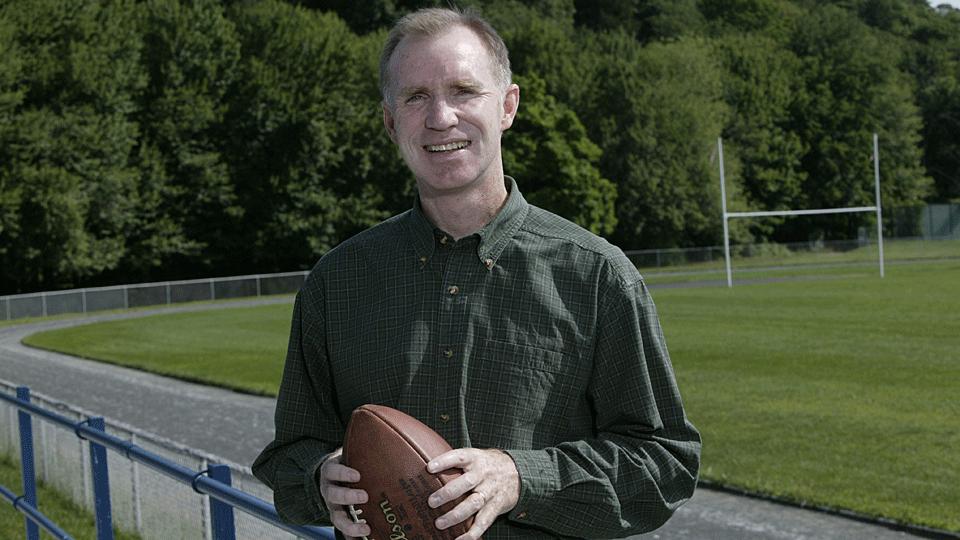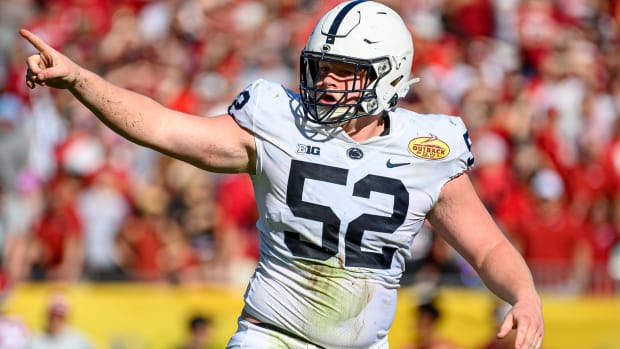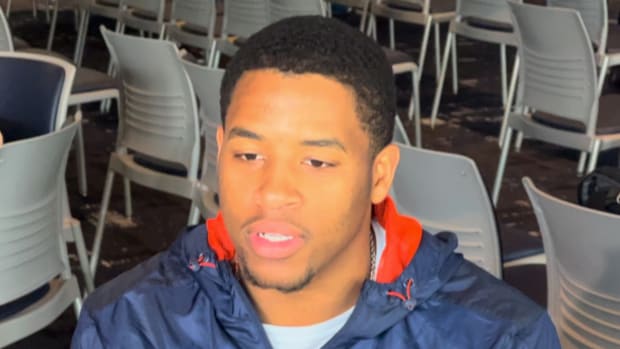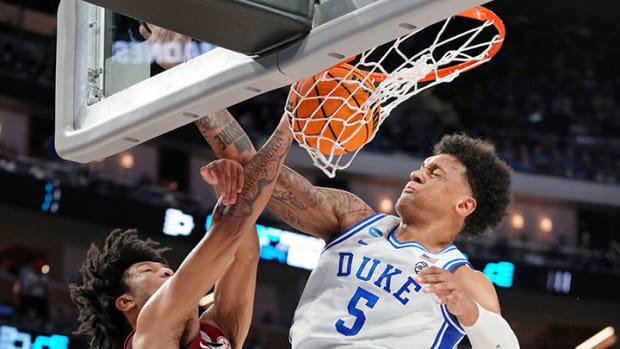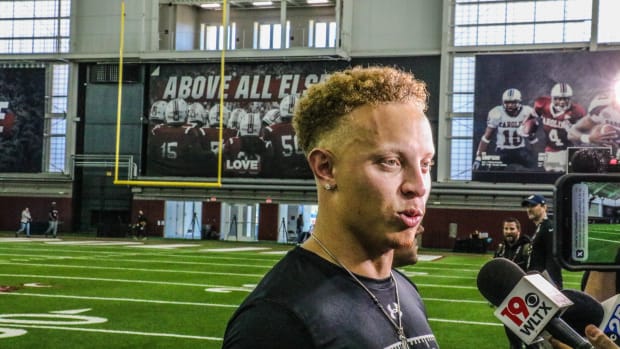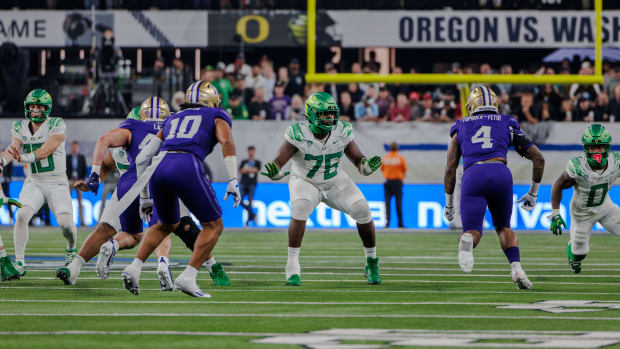SI 60 Q&A: Tim Layden on Mike Reily and an athlete dying young
Tim Layden played on the freshmen football team at Williams College in the 1970s, and almost two decades later, it was a college football story that brought him to Sports Illustrated. While covering the sport at Newsday, the Long Island newspaper, in the 1990s, Layden was in South Bend for No. 2 Notre Dame's "Game of the Century" win over No. 1 Florida State in November 1993. Then, while most of the college football media moved elsewhere the following week, Layden decided on a hunch to go back for Notre Dame's regular season finale against Boston College. The underdog Eagles pulled off a 41-39 shocker, and Layden's deadline story caught the eye of SI managing editor Mark Mulvoy, who read the account of his alma mater's huge win while riding in to the magazine's offices on the train the next morning. By the start of the next season, Layden was one of SI's lead college football writers. "I always tell journalism students: never mail in a story because you never know who might be reading it," says Layden.
In his 20 years at the magazine, millions of readers have enjoyed Layden's excellent stories, which have been written about almost every sport SI covers. However, it is, naturally, a college football story that he calls "my favorite, and probably my best." It is about Mike Reily, who starred at Layden's alma mater in the early 1960s before dying at age 21 from Hodgkin's disease. It ran in the Nov. 7, 2011 issue with the headline, "The Forgotten Hero." I spoke to him about the story for the latest Q&A in the SI 60 series.
The Forgotten Hero: Mike Reily's legacy at Williams College
SI:Did you already know the story of Mike Reily? If not, how did you learn about it?
LAYDEN: I didn’t. In February of 2011 I got a call from Dick Quinn, who is the longtime Sports Information Director at Williams. We talk frequently, and Dick is always pitching Williams stories that he thinks would make perfect stories for SI but they are never good enough or big enough for the magazine, and I always have to apologize and then help him get some athlete into Faces In The Crowd. With this one, he said, “Just give me a minute and let me tell you the story.”
He told me the story, and to me it was immediately a no brainer that it was a fabulous story that seemed like a perfect fit for SI. I thought it might be too obscure for SI, though, so I wrote up a three sentence synopsis and sent it to [assistant managing editor] Chris Hunt to see what he thought. He said, “Obviously this is a bonus. Go do it.”
• Read all of the stories and Q&As in the SI 60 series
SI: How did you get started on reporting this story that was obviously not well known?
LAYDEN: It was May or June before I dug in. I started by making a trip to Williams. I graduated from there in 1978, my daughter graduated from there in 2010, and I still stay in touch with a lot of people there. I hunkered down in a basement looking at yearbooks and old copies of the newspaper and getting a sense for the time and place of names of people that Reily played with. Right after that I drove up to New Hampshire to see Ben Wagner, who was the co-captain of the team with Reily and started this whole thing by making the call to say, “Why isn’t this guy listed as an Eph legend?” which is just a small nod to guys who are significant players.
He had lots of names and phone numbers of guys from that era. He had all the contact info for people on their team and in their class and in their fraternity house. I took those and just started making calls. The reporting was mostly done on the phone.
SI: You cover a lot of different things for SI. Did you take a break to focus just on that story for a little while?
LAYDEN: When I’m doing a story I can kind of work on a surface level at five or six things at once, but when it’s time to complete a story I have to dive in and be immersed for a few weeks, because you’re not looking at notes when you call people, you just remember what the previous guy said and the conversations flow one after another. I really focused on this story from about June 1 to July 15. There were days where I probably made five or six one hour phone calls, and those were tough because they were all very emotional, and very few of them had talked about all this.
That was very true of the trip to New Orleans to visit Mike’s family. I met his brothers in the kitchen of a house owned by Larry Eustis that was about a block from Drew Brees’ house, which I’d been to the previous year. It didn’t occur to me until an hour in to our conversation that they had never talked about Mike’s death. When they told me that, I was glad I hadn't known that. I thought I was talking to guys who got together for card games, but they were estranged and had never sat in a room together and talked about Mike’s death, ever. If I had known that going in it might have been intimidating. It was very emotional for me too but I kept it in check.
That’s so rich for storytelling when it’s an actual, real thing. It’s the same way with Ben Wagner, who felt he had unfinished business with Mike Reily. Ben is the best friend everybody wishes they had for their entire life. That was the best part of this story -- dealing with very intelligent people who had a very adult perspective on what it had meant to lose a friend when he was young. They were almost confessional about it: “I didn’t support Mike enough when he was dying because I was too young to understand.” Jack Beecham became a cancer doctor and had to help patients die, but when his best friend was 21 and dying he didn’t help him because he didn’t know how to yet.
SI: Sandy Bennett, the young woman in the story, seemed like she might have been reluctant to talk.
LAYDEN: A couple of the guys from the class of ‘64 called her ahead of time for me. They both informed me that she was someone I should talk to because she was very close to Mike in the last couple years of his life. She was hesitant, but in that time frame one of them called me and said, “Sandy’s willing to talk to you.” I think they instructed me on how to talk to her. I’d hoped to go up and see her because she lives near Williamstown, but she wasn’t’ there when I went up there so we talked on the phone several times.
She was very concerned, “Is this proper for me to say,” and “I don’t think you should write this.” I had to very carefully talk her through the process of how this might come out. As a journalist you know it will turn out OK but it doesn’t feel that way to the subject so you have to walk them across the bridge. In the end she was very happy with the story.
SI: What was she worried about in particular?
LAYDEN: The anecdote where she’s with him in the morning when he wakes up and starts coughing blood. Obviously, if she was with him in the fraternity house in the morning, she was afraid people might not be OK with it. I said, “I think people would understand that you were two young people and you were in love. Everybody has been in college and been in love, so I think people will understand.” I had to convince her that people would go with the story and embrace it.
I’ve communicated with her a few times since then, and I asked her to send me pictures of herself from that time in her life. Mike had a lot of girlfriends but as soon as I got the picture in the mail I could see why this guy was head over heels for this girl.
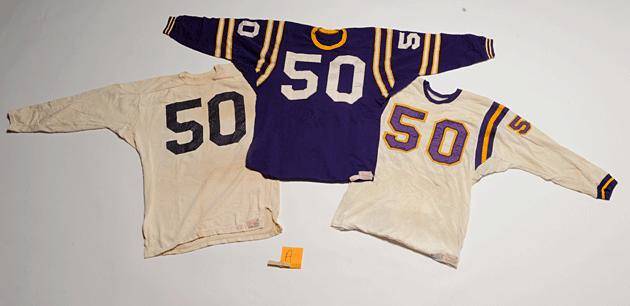
Williams quietly stored Reily's jerseys for decades and never issued his number 50 to another player.
David N. Berkwitz/SI
SI: Sometimes in these stories it seems people try to canonize the subject after the fact, but this story was refreshing because it didn’t feel like anyone was trying to turn Reily into a saint.
LAYDEN: Right, and I don’t know why that happened because I didn’t seek that out. When I got to New Orleans the brothers had a lot of pictures of them as [basically] boys in these bars at Pat O’Brien’s and over at Tulane’s and Patrick was very open and said, “Our parents partied and drank and they were happy if we got out of the house and did the same thing.” The quarterback of that team just said Mike was always partying but he was always under control, which could be because he was partying since he was a young kid.
I would have been fine if he was a saint for this story. Sometimes, and this is the benefit in writing a story about regular people rather than those who had been in the public eye, they hadn’t been taught to romanticize our stories or anesthetize them. The stories about Mike came very naturally, including the ones that were a little more negative. That was the life those guys lived in New Orleans. They had pictures to back it up. They were very wealthy and very privileged. The athletic center at Tulane is named after the Reily family.
SI 60 Q&A with John Ed Bradley: The story behind "The Best Years Of His Life"
SI: It can also seem at times with this type of story that the subject’s athletic accomplishments grow bigger by the year. His high school teammate, Charlie Shaffer, went on to play at North Carolina and suggested that Reily could have played at that level. Do you think that was the case, or was his talent closer to Williams’ level?
LAYDEN: I don’t think we’ll ever know for sure. I had a tape of the Amherst game from his sophomore year. He was 6-foot-3, 220 pounds. That was big for then; I think Dick Butkus was 6-3, 235 and he was playing in college at the same time. So [Reily] was big enough to be a linebacker in Division I for sure. He was very fast, you could see that watching tape.
So I don’t know for sure, but clearly he was a great athlete. Sometimes the very best D-III players in a lot of sports could probably play D-I at some college. Charlie obviously would romanticize Mike’s abilities a little bit. Wagner, who was the last cut from the Kansas City Chiefs in 1964, said Mike would have made that team so easily it would have been a joke. Ben views Mike as having been a superior player to him and he almost made an NFL team.
Wondering how good he was is part of the mythology of the whole thing because we will never really know. That almost makes it, in terms of this tragic and sad story, almost better. The great athlete that died young always gets bigger, faster better as time goes by. Whether that’s true of Mike I don’t know. He was the best player on him team at this little college in New England. We know that North Carolina wanted him to play, that’s a fact.
SI: Did other places want him?
LAYDEN: I don’t know. North Carolina is the only name that came up. I don’t know what recruiting was like in 1963 for kid at a private school in Virginia. A lot of those kids do go to schools like Amherst and Middlebury and Williams, though.
SI 60 Q&A: Rick Reilly on figuring out what The Citadel really was
SI: Did you know any of the equipment managers from having played sports at Williams?
LAYDEN: That was interesting because I knew to find some of those guys I had to call people that I knew that I had gone to college with. I played football as a freshman and basketball as a sophomore – I did not get on the court to speak of and I was cut as a junior -- but I knew some them.
[At one point] I went to the son of one of the equipment managers and it turned out that guy’s daughter went to Williams and married a good friend of mine. So the story kept doubling back on itself with connections that I had.
SI: Did you consider putting yourself in the story?
LAYDEN: I made a decision right at the beginning that I wasn’t going to do that. I thought this one was strong enough without me being a character in it. His life story was so interesting and these equipment managers had made this gesture so it had to be their story and not mine. A lot of people ask me that, but I also thought I might cheapen it a little. It might look like I only did it because I had a connection and this story was strong enough that I didn’t have to do that.
SI: Did it take a long time to write?
LAYDEN: I wrote it on vacation in late July and early August. We took a family trip to the beach in New England and we had the usual one week rental and I just got up every morning at 6:30 or 7 and worked until noon and then we went to the beach. I had a pretty good idea what I wanted to write. I wrote five consecutive mornings and filed to Chis Hunt on a Thursday.
The way the story is set up it’s like five sections. I think I wrote one section each morning. That agave me a natural stopping point to get in the car and go to the beach.
I sweat these things out and when you sit down with 100 pages of transcriptions and know you have to write 6,000 words, it can be pretty intimidating. Maybe it wasn’t for Frank Deford, but it was for me. I liked it, though. This one was pretty smooth. I’m not a big reviser – sometimes I take a long time to get going, but once I start writing I usually go from A to Z and I’m done.
SI: What was the response like?
LAYDEN: The response was good from the office, which I always like to hear. Chris made the decision that this would be a good story to run when Williams played Amherst in November so it would be a good fall football story. It ran in the magazine the same week as a seven or eight page story I did on Aaron Rodgers, so I was a little worried I was scooping myself.
I heard from a lot of college classmates, too. One of my best friends in college sent me an email and said, “I was reading your story on my laptop at the airport and I had to go in the bathroom and close the door because I was crying.”
SI 60 Q&A: Gary Smith on his award-winning morality tale about Richie Parker
SI: Was it still emotional for you after having worked on it for so long?
LAYDEN: You know the story is emotional, but when you’ve gone through it you don’t really feel the emotion anymore so you wonder if other people will. They did, and it was just the greatest gift you can have as a writer, to touch people’s hearts.
The day the story came out, I was in a doctor’s office for a series of procedures and I was reading tweets about this story as people were responding to it. They were responding very favorably as I was going through a life-changing medical procedure. So it was a very good news, bad news kind of morning.
A week or two after that Williams had a big event and retired his jersey officially, and I was unable to attend -- I was healthy but not in a condition where I could go out in public so I had to miss the event at Williams. Fast forward to 2014 and Williams has just built a new athletic complex -- new field, new track, new locker rooms and a big new banquet facility above the locker rooms overlooking the football field. The Class of ‘64 raised money to call that the Mike Reily room. On Oct. 10 they’ve asked me to come over and talk about the story. I couldn’t go in 2011, so this year I’m going to go.
That’s a long way of saying yes, the story still resonates. A lot of people think the story had something to do with reviving his memory, although Ben Wagner had a lot more to do with it than my story.
